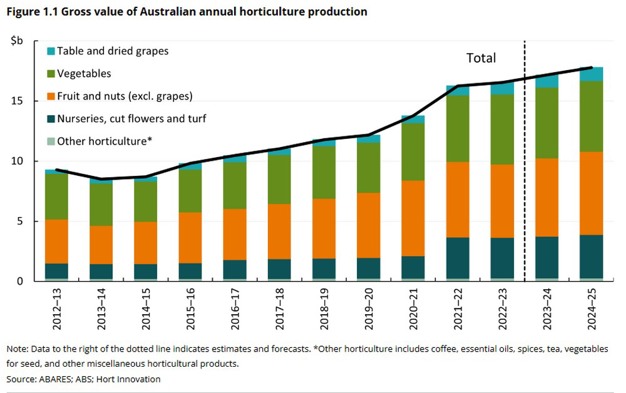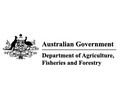The value of Australian horticulture is expected to rise in the next financial year higher than previously expected, according to the latest figures from the Australian Bureau of Agricultural and Resource Economics and Sciences (ABARES).
The September figures come after the previous Federal Agriculture Minister Murray Watt revealed at Hort Connections in June that Australia is set to produce "historic results" of over $17.4 billion in horticulture in 2024-25 – a record high.
However, the latest figures state that it will be even higher at $17.8 billion, reflecting increased production volumes and higher prices for export-focused industries.
In addition, the ABARES report stated there would be: "average to above-average seasonal conditions in key growing regions and more trees reaching maturity are forecast to lead to higher yields of fruit and nuts".
The ABARES Agricultural Commodities and Crop Reports also show significant growth in the overall agriculture sector, from $82.5 billion in 2023-24 to $86.2 billion in 2024-25, but Executive Director of ABARES, Dr Jared Greenville says not all of Australia is experiencing favourable climate conditions.
"Crop production across Australia has been driven by New South Wales and Queensland, and better than expected seasonal conditions in Western Australia," Dr Greenville said. "But unfavourable conditions in north and western Victoria and most of South Australia following below average winter rainfall have resulted in lower than expected crop production."
The value of horticulture exports is also forecast to rise by 19 per cent to a record $4.1 billion in 2024–25, driven by higher production volumes and Dr Greenville added that Australian exports continue to be in strong demand and prices in key markets.
"We're also seeing increased trade flows with China across various commodities, following improvements in market access," he said. "The horticulture industry is continuing to showcase its resilience as it maintains its forecast of record-breaking production values."
Particularly, Almond and macadamia export values are forecast to rise to $1.4 billion and Citrus export values are forecast to rise to $626 million. This is driven by higher domestic production and strong global demand.

Graphic source: ABARES Agricultural Commodities Report (Horticulture)
The report also stated: "World fruit demand is expected to rise, driven by demand for high-quality premium fruit in markets such as Japan, China and Korea. India's demand for fresh fruit continues to increase, driven by population growth and an expanding middle class".
Table grape export volumes are also forecast to rise in 2024–25, driven by strong production and increased market access to Japan - especially after the announcement that exporters will now be able to ship over 130 table grape varieties to Japan, following the removal of variety restrictions in July 2024.
Just this week, after the release of the ABARES report, the Australian government announced a Free Trade Agreement with the United Arab Emirates (UAE), which is a key trading partner of Australian vegetables.
According to peak body AUSVEG, Australia exported almost 40,000 tonnes of vegetables are sent to the UAE, worth $34 million, making the nation the second largest export destination for Australian vegetable produce by value, and largest by volume. This included 33,000 tonnes of carrots, more than 4,200 tonnes of onions, and nearly 2,000 tonnes of potatoes. AUSVEG CEO Michael Coote said the securing of the deal was an important development in the longer-term trading relationship between Australia and the UAE.
"The UAE is a key and valued long-term trading partner for the Australian vegetable industry," said Mr Coote. "This deal is an important step that will lock in and underpin the vegetable industry's ability to trade competitively in a UAE market."
However, ABARES also noted that domestic fruit and vegetable prices are expected to decline in 2024–25 as higher production volumes more than offset an expected rise in demand.
Despite the improved market access and export growth, there are challenges such as rising input costs, potential reforms to the Working Holiday Maker visa program and biosecurity threats that pose an ongoing risk to horticulture production.
To view the full ABARES horticulture outlook, click here.
 Department of Agriculture, Fisheries and Forestry
Department of Agriculture, Fisheries and Forestry
+61 2 6272 3933
[email protected]
www.agriculture.gov.au/abares
